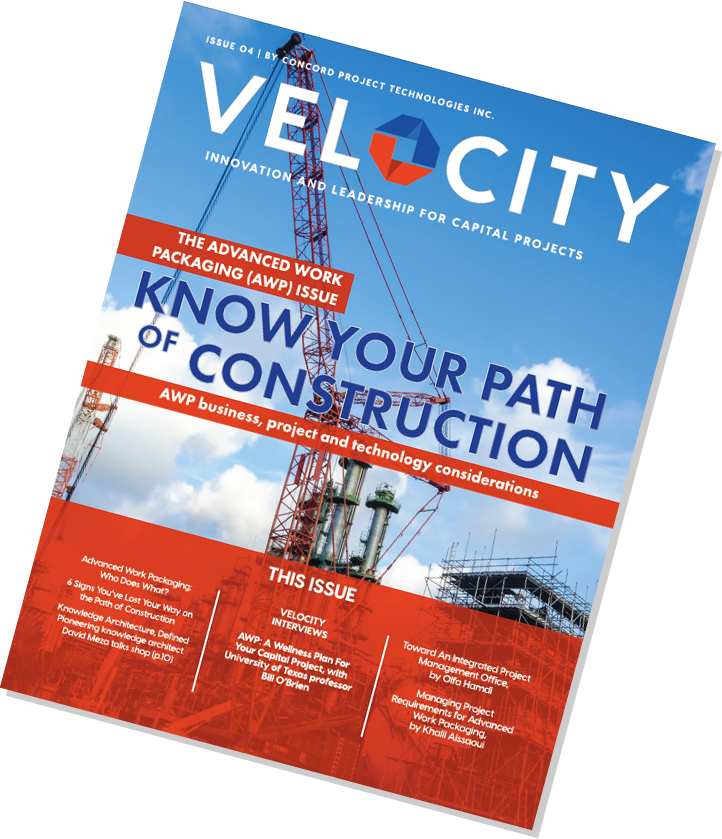Our industry is in the middle of a fundamental paradigm shift. If you’re not paying attention, you’ll be left in the dust.
It has become impossible to ignore the fact that construction-driven capital projects work best. Reams of data show that even the most ambitious projects are more likely to be on-time and on-budget when everybody is working in service of the construction team. It turns out that the people wearing steel-toed work boots and neon-striped dungarees — the people who are actually building the capital project — should be the boss of us all.
Talk about a paradigm shift.
This painfully slow, collective realization is a fortuitous by-product of Advanced Work Packaging. We started out thinking that AWP was just a slightly different approach to what we’d always done. After all, the labor and materials (almost) always got to the site and the projects (almost) always got done, so we had to be doing something right. Right?
Wrong. Forcing ourselves to think about work packages in advance has revealed how shockingly bad we are at ensuring that our construction teams have the labor and materials they need to get things built. Bringing construction leaders into the room during the planning phases compounded that realization.
Suddenly, the cause of the cost and schedule overruns became glaringly obvious — we’ve been doing it all backward.
It gets worse: As an industry we’ve been focused exclusively on management, endlessly tweaking and fine-tuning and re-inventing the processes that get us from concept to construction. That’s not enough anymore: It’s time for leadership.
Embracing a construction-driven paradigm requires a radical rethinking of the modern capital construction process. I started out by saying that the benefits of transitioning to a construction approach are impossible to ignore, and that’s not just hyperbole: If you aren’t transitioning, you’ll be left behind.
As you embark on these changes, I’d like to propose a new way of looking things — a new way of leading. It’s impossible for me to say precisely what needs to happen in your unique organization, but these three “lenses” can help you see the road ahead much more clearly.
1 | The Team Leadership Lens
The leadership profile of every member of your team matters more than you think. In any organization, at every level, collaborative leaders are worth their weight in gold. Take, for example, two project schedulers, both equally proficient in Primavera. One delivers the schedule, but second schedules the work and ensures that everyone engages with it. This is leadership: Going beyond pure technical competence to actively drive results.
The capital project industry needs to start identifying and investing in cultivating leadership skills at the functional/discipline levels — not just the executive/leadership levels. Why? Because as you embark on this transitional journey, you need a team of leaders.
Embracing a construction-driven paradigm requires a radical rethinking of the modern capital construction process.
Olfa Hamdi Tweet
2 | The Cultural Lens
Starting now, Construction is King. From start to finish, everyone involved in a project should be working in service of the construction team. To say that this requires a paradigm shift is a profound understatement — the cultural transformation that needs to happen will touch every single project participant, from the Owner on down.
The biggest change will happen at the engineering level. Engineering teams are made up of highly educated, extraordinarily skilled, well-compensated professionals who bear a great deal of legal and practical responsibility for a project. These professionals must be persuaded that all of their work is in the service of the construction team. What will it take to change the culture?
One thing is certain, it won’t happen on its own. Ultimately, leadership means that Owner companies will have to pull the collaborative and contractual levers they have at their disposal to make this transformation happen. Once Owner companies see the financial and other benefits of running a construction-driven project, they will no longer be willing to work with engineering firms that do not understand how to work with and support construction.
The construction-first mindset is the way of the future.
3 | The Relationship Lens
We know two things: The relationship between the business side and the project side is a critical one, and that we need to bridge the gap between the two. When business leaders aren’t talking to project leaders, they make important decisions without fully considering the project ramifications. High-functioning teams and organizations deserve better.
I’ll be honest and say we don’t yet have a clear picture as to how to accomplish this. Some of the most promising practices we’ve seen involve rotating people through business, sponsorship, project, turnaround, shutdown and marketing, to build leaders who understand the full scope of operations. These people are unique in the field, and they become sought-after leaders with some of the most effective profiles we’ve seen. We’ll keep you posted on any new findings.
In sum, the transition won’t be easy. There are bumpy roads ahead, with blind curves and steep drop-offs. But organizations who start now are in the best position to leverage the power of transformation. Why not yours?





